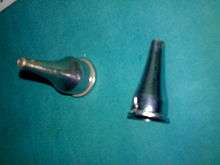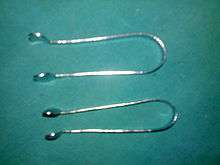List of instruments used in otorhinolaryngology, head and neck surgery
Instruments used specially in Otolaryngology (Otorhinolaryngology, head and neck surgery) i.e. ENT are as follows:[1][2]
Instrument list
| Instrument | Uses |
|---|---|
| Head Mirror with head band | to focus light into the cavity under inspection; mirror is concave and is used with a Chiron lamp to produce a parallel beam of light; doctor views through the hole (average diameter of mirror is 3 & 1/2" & that of hole is 1/4") |
| Head mounted lights with head band | to focus light into the cavity under inspection |
| Chiron lamp | source of light |
| Katz extractor | to remove nasal foreign body |
| Bull's eye lamp | source of light; exiting lens is convex and produces a divergent beam of light |
| Speculum | to dilate orifices and to see inside |
| •Thudichum's nasal speculum | -do-; short blades ( uses: anterior rhinoscopy - to see the Little's area, ant-inferior part of nasal septum, anterior part of inferior and middle turbinate and meatus, as well as any pathological lesion in the area; also used in certain nasal operations ) |
| •St. Clair Thompson's long bladed nasal speculum | -do-; long blades ( uses: in operations such as Submucous Resection of the nasal septum ) |
| •Killian's long bladed nasal speculum | -do-; long blades and with handles; used more operations like SMR & Septoplasty. ( advantage: blade can be adjusted and fixed with screws, to avoid strain due to holding ) |
| •Lempert's endaural speculum | open the ear canal |
| •Seigle's pneumatic speculum | open the ear canal and give a magnification; test the mobility of tympanic membrane; see a magnified image of small perforations; introduce medicine into middle ear; perform Fistula test for vestibular function |
| •Aural/Ear speculum | to fit in and straighten the external ear canal |
| Lack's tongue depressor | to depress or remove the tongue or other structures from the field of inspection or to view them from all sides; examine oral cavity; posterior rhinoscopy; minor operations; foreign body removal; biopsy ;peritonsillar abscess drainage; retraction of cheek and lip. |
| Forceps | to hold things [3] |
| •Asch's septum forceps | used to work on the nasal septum |
| •Tilly's nasal dressing forceps | for use in the anterior part of the nasal cavity Jmost importantly, anterior nasal packing; larger than Hartmann's, serrated tip & box joint ( uses: all nasal operations; nasal packing; removal of fish bone ) |
| •Tilly's aural dressing forceps | for use in the ear canal; larger than Hartmann's |
| •Hartmann's aural forceps | for use in the ear canal; smaller than Tilly's and has a better "biting" action |
| •Hunter Tod's forceps | for use in the ear canal |
| •Fagge's aural forceps | for use in the ear canal |
| •Waugh's long dissecting forceps | used for dissection like on the tonsils, also to catch bleeding points and putting in swabs |
| •Wilson's tonsil artery forceps | as an a haemostat ( same as Negus ) |
| •Negus tonsil artery forceps | as a haemostat, replaces tonsil artery forceps; used to tie ligature at a depth and ligature won't slip due to its curve tip. |
| •Peritonsilar abscess forceps | to drain abscesses in the soft tissue adjacent to the palatine tonsils |
| •Denis Brown's tonsil holding forceps | to hold the tonsil during dissection |
| •Luc's nasal forceps | used in Caldwell-Luc operation operation on the maxillary sinuses |
| •Walsham forceps | used to work on the nasal septum |
| •Citelli's punch forceps | punching out holes in bones or other tissues |
| •Henckle's punch forceps | punching out holes in bones or other tissues |
| Eustachian (tube) catheter | on certain procedures of the eustachian tube or the middle ear like patency test; inflate middle ear and clear eustachian tube blockade; removal of foreign body of the nose; as a suction cannula. |
| Mirrors | |
| •Laryngeal mirror | straight mirror for indirect laryngoscopy (seeing the larynx); structure seen are the base of tongue, vallecula, glossoepiglottic fold, epiglottis, pharyngo-epiglottic folds, aryepiglottic folds, epiglottis, interarytenoid region, pyriform sinus, inlet of larynx, supraglottic region, ventricular bands, vocal cord, subglottis and few rings of trachea; used for removal of fish bone, biopsy, anaesthesia of larynx, trachea, bronchi; removal of vocal nodule and papilloma. |
| •Postnasal/Posterior rhinoscopy mirror (St. Clair Thompson's) | for posterior rhinoscopy (seeing the inner parts of the nose like the choanae) |
| Bronchoscope | hollow tube to see within the respiratory tract without obstructing respiration |
| Oesophagoscope | hollow tube to see within the oesophagus |
| Laryngoscope | used in direct laryngoscopy; vide link |
| Jobson Horne's probe with ring curette | to access or clean the external ear |
| Tuning forks | for various clinical tests of hearing loss; vibration sense test |
| Pritchard's politzerization apparatus | vide link |
| Aural/Ear syringe | used to flush out anything like ear wax or foreign bodies from the external ear |
| Toynbee's auscultation tube | |
| Otoscope/Auriscope | to examine the external auditory canal and ear drum; used during aural toileting, removal of wax, myringotomy, stapedectomy and to dilate the stenosis of canal |
| Mouth gag | - |
| •Doyen's mouth gag | to keep the mouth open, mostly operate the mouth |
| •Boyle Davis mouth gag | to keep the mouth open and depress the tongue to operate within or through the mouth; operations in which it is used: tonsillectomy, operation of palate, pharynx, nasopharynx. |
| •Jenning's mouth gag | -do- |
| Draffin's bipod metallic stand and Magauran's plate | used to hold the Boyle Davis mouth gag fitted head in a particular place. |
| Guillotine | used in guillotine method of tonsillectomy |
| Gwyenne Evans Tonsil dissector and anterior pillar retractor | used in tonsillectomy |
| Snares | - |
| •Eve's tonsil snare | to remove tonsil - used at the end to minimize bleeding |
| •Krause's nasal snare | used to remove nasal polyps |
| •Glegg's nasal polyp snare | used to remove nasal polyps |
| •Aural snare | used to remove aural polyps |
| Tonsil knife | used in tonsillectomy.incission of anterior pillar of tonsil in the beginning of operation |
| Yorke's tonsil haemostatic clamp | haemostatic clamps |
| Negus' ligature slipper/knot tier | used with Negus's or Wilson's artery forceps to help tie sutures; help to slip the ligature over the tip of Negus or Wilson forceps during ligation of vessels following tonsillectomy. |
| Negus' artery forceps | as a haemostat; replace tonsil artery forceps; ligature will not slip due to curve tip. |
| St. Clair Thompson adenoid curette with cage and guard | used in adenoid surgery.held in dagger holding fashion and passed behind soft palate. |
| Yankauer's nasopharyngoscope | for a direct access or look at the nasopharynx |
| Yankauer suction tip | double bent sucker; used as a sucker in operations of the mouth |
| Lichtwitz antrum-puncture trocar and canula | used in nasal sinus surgery; conform presence of puss in maxillary sinus; cytological examination of antral wash out fluid; lavage of the maxillary sinus; introduction of medication and indwelling polythene tube into the sinus |
| Tilly's antral harpoon trocar | to create an artificial passage into the maxillary sinus through the nose; puncture medial wall of inferior meati |
| Tilly's antral bur | to enlarge the artificial passage into the maxillary sinus through the nose made by the harpoon trochar; dilate and smoothen the antrostomy opening |
| Freer's double-ended mucoperichondrium elevator | separation of the mucosa from the cartilage in nasal surgery like Septomarginal resectiondisplacement of inferior turbinate |
| Farabuef's periosteal elevator | used in mastoid surgeries like mastoidectomy |
| Rose's sinus washing canula | to irrigate the maxillary sinuses |
| Higginson's syringe | irrigating the antrum,nasal douching for atrophic rhinitis |
| Ballenger's swivel knife | cutting septal cartilage; SMR operation |
| Nasal foreign body hook | to remove nasal foreign bodies |
| Electric drill | for bone drilling |
| Mollison's self-retaining haemostatic mastoid retractor | used in mastoid surgeries to retract overlying tissues |
| Staecke's guide and protector | used in mastoid surgeries |
| Chisel | removing parts of bones |
| Mastoid gouge | removing parts of mastoid bones |
| MacEwen's cell seeker with curette | used to curette within the mastoid |
| Lempert's curette or scoop | removing parts of the nasal septum |
| Killian's nasal bone gouge | bayonet shaped; removing parts of the nasal septum |
| Myringotome | used to cut the ear drum |
| Grommet stapedectomy set | used in surgeries of the ear drum |
| Tracheostomy tube | used in tracheostomy to bypass the airway above its point of insertion, due to any reason |
| •Fuller's bi-valve type | metal double tube; used in a new tracheostomy or during closing it for a few days |
| •Portex type | used in permanent tracheostomy |
| •Cuffed type | in unconscious patient (single cuff is sufficient); used in permanent tracheostomy (with two cuffs); has a balloon (cuff) that is inflated to occlude the airway around the tube to prevent aspiration of fluids into the lungs |
| •Jackson's | metal double tube and a pilot |
| Retractor's (single or double hook) | to retract tissues |
| Tracheal hooks (blunt or sharp) | used in tracheostomy |
| Lempert's endural retractor | used in ear surgery |
| •Jansen's self retaining | self retaining retractor used in mastoid surgery |
| •Mollison's self retaining haemostatic | self retaining retractor used in mastoid surgery |
| Tracheal dilator | used in tracheostomy to dilate the cut edges of the trachea |
| Long gauze pieces | for anterior nasal packing |
Image gallery
-

Aural or ear syringe
-

Bull's eye lamp
-

Foreign body hook
-

Head Mirror
-

Aural/Ear speculum
-

Hartmann's aural forceps
-

Hartmann's aural forceps
-

Jobson Horne's probe with ring curette
-

Lack's tongue depressor
-

Laryngeal mirror
-

Otoscope or Auriscope
-
Pritchard's politzerization apparatus
-

Posterior rhynoscopy mirror
-

Thudichum's nasal speculum
-

Tilly's nasal dressing forceps
-

Tilly's nasal dressing forceps
-
Fuller's bivalve metal tracheostomy tube
-

Plastic tracheostomy tube
-
Single hook retractor
-
Double hook retractor
-

Surgical sponge forceps
-
Fagge's aural forceps
-
Tonsil artery forceps
References
- ↑ ENT and head neck surgery by Dr. S K. De, ISBN 81-87447-16-8
- ↑ Diseases of the ear, nose and throat by Dr. P. L. Dhingra, 4th Edition, ISBN 81-312-0327-1
- ↑ DOWNS Surgical
Navigation Box
| ||||||||||||||||||||||||||
This article is issued from Wikipedia - version of the Tuesday, January 27, 2015. The text is available under the Creative Commons Attribution/Share Alike but additional terms may apply for the media files.